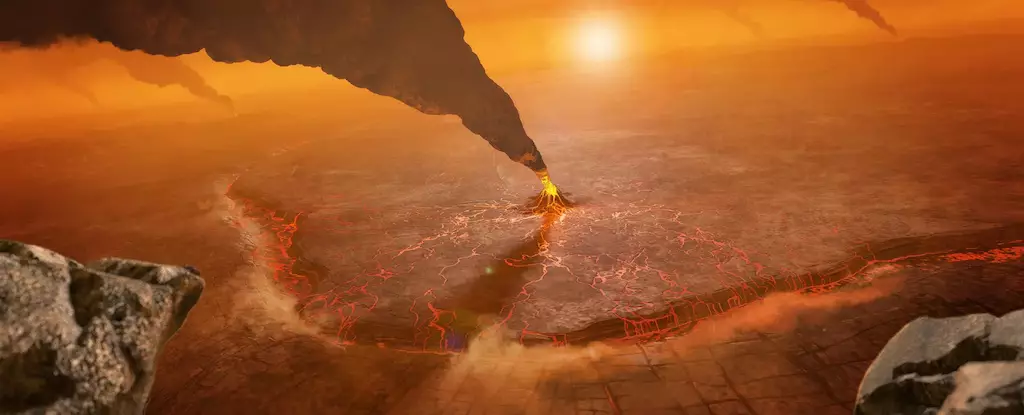Venus, often labeled Earth’s twin due to its size and proximity, remains one of the most enigmatic bodies in our solar system. For decades, scientists have marveled at its hostile environment filled with high pressures, extreme temperatures, and thick clouds of sulfuric acid. However, startling new findings suggest that beneath its deceptive surface lies a world much more dynamic than previously imagined. Recent studies utilizing archival data from missions over the last few decades propose that Venus might exhibit tectonic processes akin to our own planet, challenging outdated assumptions about its geological inactivity.
This revelation stems from an analysis that targets the coronae—large, circular features on Venus resembling crown-like structures. These intriguing formations, once thought to be mere craters, are believed to be volcanic in nature, formed by internal plumes of hot material arising from the planet’s depths. By utilizing data on gravity and topography, researchers have unveiled a tectonic-like activity that necessitates further scrutiny into what could be occurring deep within Venus’s crust.
The Mystery of Coronae
What are coronae, and why are they so significant? These geological features measure up to hundreds of kilometers wide and are characterized by raised rings surrounding a sunken center, with distinct concentric fractures radiating outward. Initially classified as craters, they have now emerged as critical indicators of volcanic and tectonic processes at play on Venus. Their formation is thought to result from hot mantle plumes pushing against the planet’s surface, creating a dome that eventually collapses inward, leading to a characteristic ring structure.
The study’s analysis points to an intriguing hypothesis: that these coronae are the modern-day representatives of processes that might have once dominated Earth when it was still a young planet. The similarities between Venusian coronae and the tectonic phenomena we witness on Earth beckon a comparative exploration that could reshape our understanding of planetary geology.
The Role of Plume Dynamics
In Venus, where traditional plate tectonics is absent, scientists propose that mantle plumes might function in a manner reminiscent of tectonic interactions on Earth. On our planet, subduction occurs when one tectonic plate slides beneath another, leading to transformations in the crust. A parallel theory suggests that as plumes exert pressure upward, they could force the surrounding surface materials outward, leading to collision with adjacent areas and resulting in certain sections being pushed into the mantle.
Alternatively, the process termed lithospheric dripping presents another fascinating layer to this narrative. Here, heating from below causes sections of the upper mantle to start melting, creating cool but dense drips that eventually detach and sink into the deeper layers of Venus’s interior. While theoretical, these insights are vital in validating the existence of dynamic geological processes on a planet long thought to be stagnant.
The Challenge of Exploration
While the latest research paints a tantalizing picture of volcanic activity and tectonic-like movements on Venus, exploration remains a formidable challenge. The planet’s searing surface temperatures reaching upwards of 900 degrees Fahrenheit, coupled with crushing atmospheric pressures, make it an inhospitable environment for spacecraft and probes. Past missions, such as NASA’s Magellan probe, have laid the groundwork by offering crucial data on Venus’s topography and gravity, but the quest for a comprehensive understanding of its geology has just begun.
The abundance of coronae provides a promising avenue for future exploration. By analyzing these colossal formations, geologists might glean insights about not just Venus’s history, but perhaps the early geological processes that could inform our knowledge about Earth’s formative years. The presence of active geological processes on Venus ignites curiosity, compelling researchers to advocate for new missions aimed at uncovering the planet’s concealed dynamics.
Venus: A Mirror to Earth’s Past?
Consider the implications of these findings; if Venus is indeed undergoing geological processes that resonate with those of early Earth, our understanding of planetary evolution may need a serious overhaul. Rather than being viewed as a static, alien world, Venus could serve as a vital piece of the puzzle—offering clues about our own planet’s past transformations. The idea that geological processes are ongoing on Venus reshapes our perception of it as a static, lifeless body and instead illustrates it as a dynamic entity still capable of change.
As interest in Venus increases, we are not merely witnessing the reclassification of a celestial body; we are potentially unlocking the door to a new era of planetary science where we can include Venus in discussions about Earth-like geology throughout the cosmos. The comparison between our two planets may soon yield revelations that transcend the boundaries of science, inviting us to reflect on the intricate dance of geological dynamics that thread through the narrative of planetary development within our solar system.

